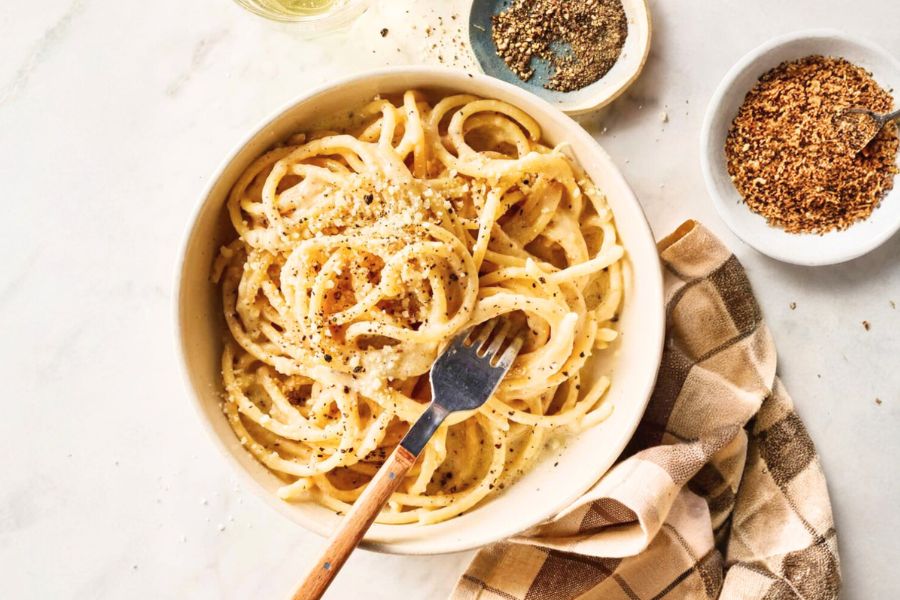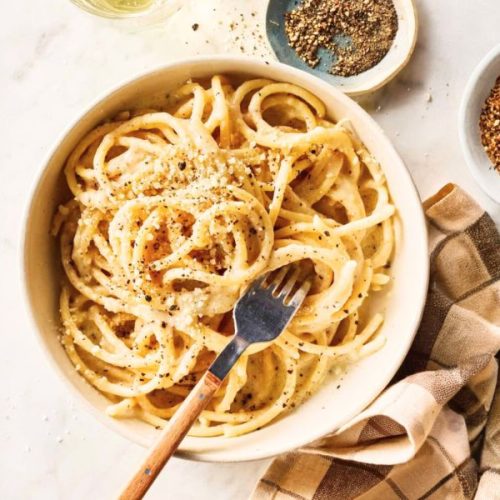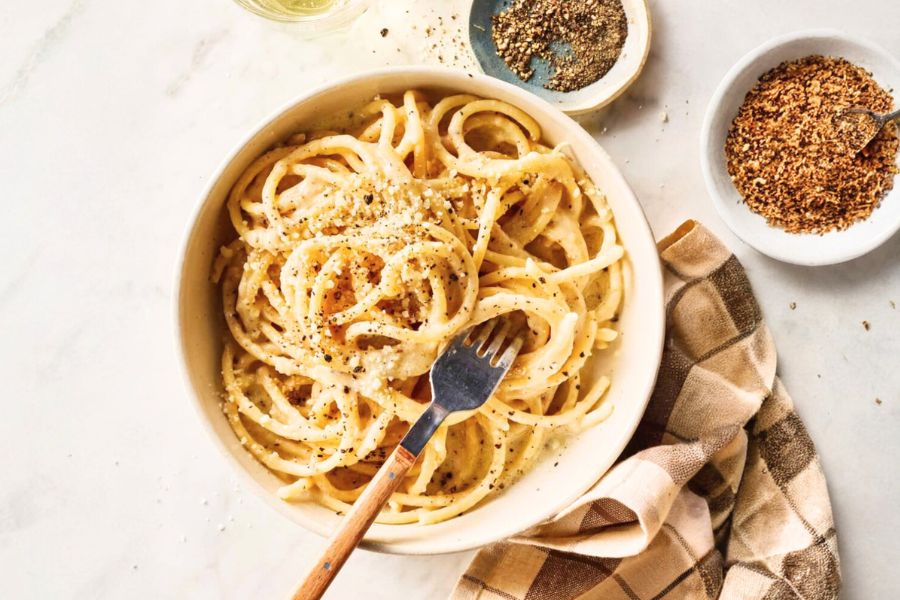Cacio e Pepe is a timeless Roman classic that shines in its simplicity and bold flavors.
This recipe stands out by incorporating a touch of butter to ensure the sauce emulsifies smoothly, creating a luscious, glossy coating for the pasta.
Rich in Pecorino Romano cheese, it offers a good source of protein and calcium, essential for muscle repair and bone health.
The black pepper adds not only a distinctive spicy warmth but also potential antioxidant benefits.
With just a few high-quality ingredients, this dish is low in carbs and free from heavy creams or oils, making it a lighter, yet deeply satisfying meal.
Its quick preparation time and minimal cleanup make it an excellent choice for busy weeknights or last-minute dinners, offering comfort without complexity.

Whether you’re a seasoned cook or a kitchen novice, this recipe delivers authentic Italian flavor with effortless technique.
Must-Have Tools for Perfect Results
Nonstick Skillet (10-inch)
Ideal for evenly melting butter and toasting black pepper without sticking. Its versatility makes it indispensable for sautéing, frying, and simmering in everyday cooking.
Large Pot
Perfect for boiling pasta to al dente perfection. A durable pot with ample capacity helps prevent water from boiling over and ensures even cooking.
Tongs
Essential for transferring hot pasta directly from pot to skillet without losing the starchy water that helps form the sauce. They offer precision and safety when handling delicate ingredients.
Fine Grater
Crucial for finely grating Pecorino Romano cheese to achieve the perfect texture, allowing it to melt smoothly into the sauce. Also useful for zesting citrus and grating spices.
Measuring Cups
Accurate measurement of pasta water and cheese ensures the sauce’s consistency is creamy and balanced, preventing it from becoming too dry or watery.

20-Minute Cacio e Pepe
Equipment
- 1 Large Pot
- 1 Nonstick skillet (10-inch)
- 1 Pair of tongs
- 1 Fine grater
- Measuring cups (at least ⅓ cup)
Ingredients
- 8 ounces bucatini pasta
- 2 tablespoons unsalted butter
- 1 teaspoon freshly cracked black pepper coarse grind, plus extra for garnish
- 2 ounces Pecorino Romano cheese finely grated (about 1 cup), plus more for serving
- Salt for pasta water
Instructions
- Prepare the Pasta Water and Cook Pasta: Fill a large pot with water, add a generous pinch of salt, and bring it to a rolling boil. Once boiling, add the bucatini pasta and cook according to package instructions until just tender but still firm to the bite (al dente). Stir occasionally to prevent sticking.
- Toast the Pepper and Melt Butter: While the pasta cooks, place a 10-inch nonstick skillet over medium heat. Add the unsalted butter and let it melt completely. Sprinkle in the freshly cracked black pepper and toast it gently for about 30 seconds, allowing its aroma to deepen and infuse the butter. Remove the skillet from heat to prevent burning.
- Transfer Pasta and Create Sauce Base: When the pasta is nearly al dente, use tongs to lift it directly from the boiling water and place it into the skillet with the butter and pepper mixture. Be sure to also add about ⅓ cup of the hot pasta water to the pan—this starchy liquid is key to emulsifying the sauce.
- Incorporate Cheese and Toss: Add half of the grated Pecorino Romano cheese to the pasta and toss vigorously to coat the strands evenly. Then, gradually add the remaining cheese while continuing to toss and stir. The heat and pasta water will melt the cheese, forming a creamy, glossy sauce that clings beautifully to each piece of pasta. If the sauce seems too thick or dry, add a tablespoon or two more pasta water, tossing until you reach a smooth consistency.
- Serve Immediately: Plate the pasta right away, garnishing with extra Pecorino and a fresh grind of black pepper to taste. Enjoy warm for the best flavor and texture.
Notes
- Cheese Texture: For the best sauce, finely grate your Pecorino Romano cheese so it melts evenly. A coarse grate can lead to clumps.
- Pasta Water: Don’t forget to reserve some pasta water before draining; its starch content is essential for a creamy sauce without cream.
- Butter Addition: Butter helps create a silkier sauce and prevents the cheese from clumping, but it’s optional if you prefer the classic recipe.
- Pasta Choice: Bucatini is traditional, but spaghetti or tonnarelli work well as substitutes.
- Serving Suggestion: Pair this dish with a simple green salad or roasted vegetables for a balanced meal.
Chef’s Secrets for Creamy Sauce
Achieving a perfectly creamy Cacio e Pepe sauce is all about technique and timing.
One of the chef’s best-kept secrets is using reserved pasta water—the starchy liquid is essential for emulsifying the cheese and butter into a silky sauce that clings to every strand of pasta.
Another tip is to toss the pasta off the heat; this gentle warmth prevents the cheese from clumping or becoming grainy.
Adding butter not only enriches the flavor but also smooths the sauce’s texture, making it easier to coat the pasta evenly.
Using freshly cracked black pepper rather than pre-ground pepper elevates the dish’s aroma and delivers a more vibrant bite.
Lastly, finely grate your Pecorino Romano cheese for quick melting and a luscious finish.
Serving Suggestions to Impress Guests
Cacio e Pepe is wonderfully simple but pairs beautifully with a variety of sides and beverages to create a memorable meal.
For a fresh contrast, serve alongside a crisp arugula salad dressed with lemon vinaigrette—its peppery bite complements the pasta’s richness.
Roasted or grilled vegetables like asparagus or zucchini add earthy notes and texture.
If you want to keep things traditional, a light white wine such as Pinot Grigio or Verdicchio enhances the cheese’s tanginess without overpowering the dish.
For an indulgent touch, sprinkle toasted pine nuts or fresh herbs like parsley on top.
This dish also makes a satisfying meal prep option—store leftovers separately from sauce, then gently reheat with a splash of pasta water.
Storage Tips for Best Freshness
If you have leftovers, store the pasta and sauce separately in airtight containers to maintain freshness and texture.
Refrigerate the pasta for up to 2 days and the sauce (butter, cheese, and pepper mixture) for up to 3 days.
When reheating, warm the pasta gently in a skillet with a small amount of reserved pasta water or fresh butter to help revive the creamy consistency.
Avoid microwaving as it can dry out the sauce and make the cheese clump.
For longer storage, the pasta can be frozen but may lose some texture.
Always taste and adjust seasoning before serving leftovers to keep the flavors bright and balanced.
Frequently Asked Questions Answered
1. Can I use other types of pasta?
Yes! While bucatini is traditional for its hollow center, spaghetti or tonnarelli are excellent substitutes and work perfectly to hold the sauce.
2. Is butter necessary in this recipe?
Butter is optional but highly recommended. It adds richness and helps create a smooth, silky sauce that’s easier to emulsify with the cheese.
3. How do I prevent the cheese from clumping?
Use finely grated Pecorino Romano and toss the pasta off the heat with pasta water gradually added. This gentle emulsification prevents clumps and ensures a creamy sauce.
4. Can I prepare this recipe vegan or dairy-free?
This recipe relies heavily on Pecorino Romano cheese and butter, which are dairy products. For vegan options, substitute with plant-based cheeses and a vegan butter alternative, but the flavor will differ.
5. What’s the best way to reheat leftovers?
Reheat gently in a skillet with a splash of reserved pasta water or fresh butter to restore the sauce’s creamy texture. Avoid the microwave to prevent drying out.
This recipe has been adapted and simplified from the original version by loveandlemons. We’ve refined the steps for a smoother cooking experience and added helpful notes, nutrition insights, and essential kitchen tools to make it even easier for home cooks.

